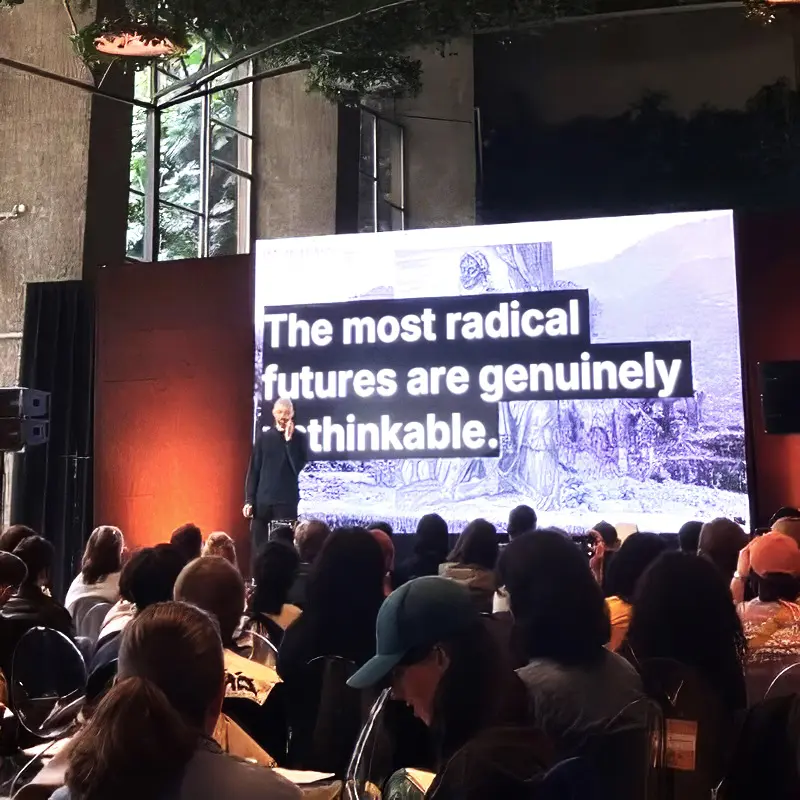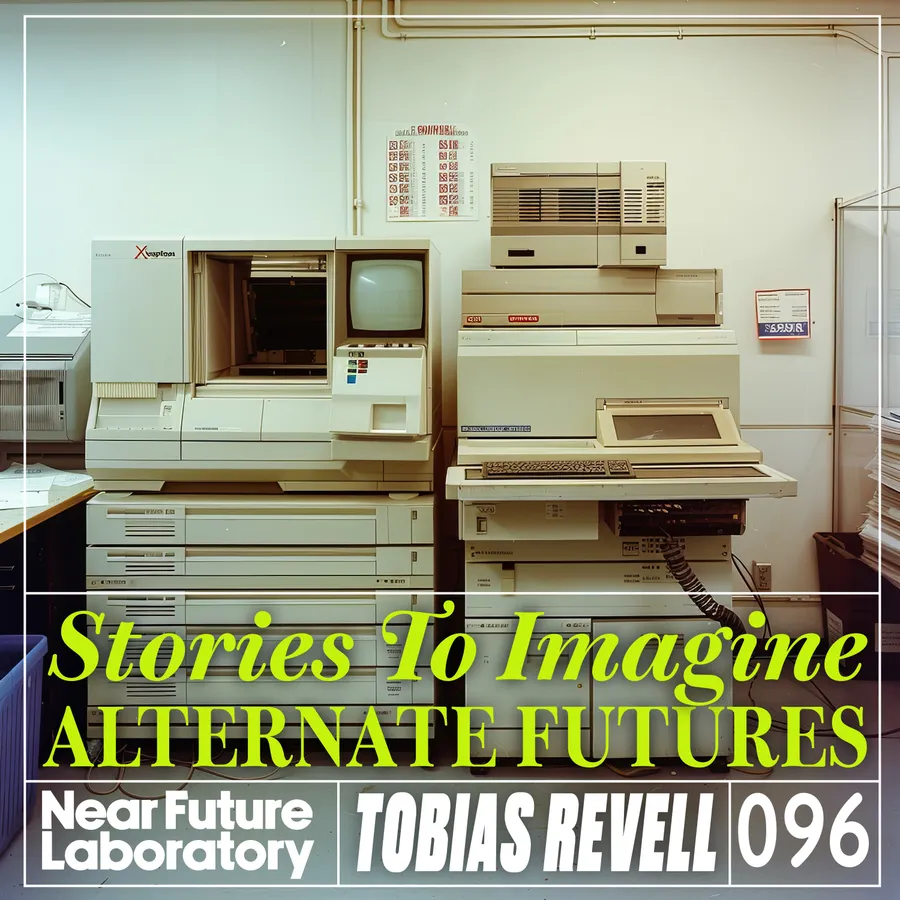Near Future Laboratory Blog
Thoughts, Reflections, Updates & Week Notes
Apr 20, 2025 – May 13, 2025
w17/w18/w19/w20/ 
May 13, 2025
Yesterday was the first session of General Seminar Season 06, Episode 05. Good fun. Great group. We made some artifacts from an agentic future, and I put some up in the Dispatches from the Near Future section of the site, including this one, Faraday's Cage: A Bar and Grill and Dré's Agentic & Digital Twin Decommissioning Service Kiosk
Imagining into the future through generative artifacts and design fiction is a way to explore the implications of agentic AI and digital twins in our lives. The value of doing this kind of work is to venture into these new and unfamiliar territories with a sense of both playfulness and practicality. The actions and activities can lead to new insights, prototypes, concept development, and even new business models.
This post showcases some of the artifacts created during General Seminar, including "Faraday's Cage: A Bar and Grill" and "Dré's Agentic & Digital Twin Decommissioning Service Kiosk."
Imagining into the future through generative artifacts and design fiction is a way to explore the implications of agentic AI and digital twins in our lives. The value of doing this kind of work is to venture into these new and unfamiliar territories with a sense of both playfulness and practicality. The actions and activities can lead to new insights, prototypes, concept development, and even new business models.
This post showcases some of the artifacts created during General Seminar, including "Faraday's Cage: A Bar and Grill" and "Dré's Agentic & Digital Twin Decommissioning Service Kiosk."
agentsagenticdiegetic prototypesfuturedesign fictionspeculative designgeneral seminarartifacts

May 10, 2025
We use diegetic prototypes as a kind of production design from the future. These are like objects that have fallen into our laps that implications of possibility — whether from the future, some adjacent now, or some other timeline. They could even be thought of as things that are contemporary, but from a different perspective, culture, or context. They are not predictions, but rather invitations to think about the future in a different way.
diegetic prototypedesign fictionmagazine from the future

May 06, 2025
The OMATA One is an exemplar of a hybrid mode of futuring — one that moves quickly from speculation to making to commercial product. It started with a simple idea: to create a cycling computer that was easy to use, accurate, and beautiful. I wanted to feel what it was like to create a product that effervesced the analog-mechanical feel of what it is to ride a bicycle, but did not require a smartphone, nor was over-indexed on the visual semantics of the already overclocked digital world.
prototypingdesignimaginationmakingfuturesdesign fictionproduct design

May 05, 2025
TL;DR:
Less yammering. More hammering.
If there’s one thing getting in the way of Imagining better futures, it’s not capitalism or collapse — it’s us. The self-proclaimed futurists. The critics of self-proclaimed futurists. The endless theorizing, posturing, and purity tests.
Let’s collaborate more. Make more. Imagine harder.
The hustle may stink, but most of us are in this because we sense something worth doing — something that might help. If it gets even one person to see “the future” differently and helps pay rent? That’s a win.
Thanks to @Silvio Lorusso for sparking this.
Less yammering. More hammering.
If there’s one thing getting in the way of Imagining better futures, it’s not capitalism or collapse — it’s us. The self-proclaimed futurists. The critics of self-proclaimed futurists. The endless theorizing, posturing, and purity tests.
Let’s collaborate more. Make more. Imagine harder.
The hustle may stink, but most of us are in this because we sense something worth doing — something that might help. If it gets even one person to see “the future” differently and helps pay rent? That’s a win.
Thanks to @Silvio Lorusso for sparking this.
futuresdesignimaginationcollaborationless yammering more hammering

May 05, 2025
Strategy isn’t a plan. It’s a provocation. A story about a future you’re willing to bet on. It’s not prediction. It’s preparation. Slide decks don’t move people. Artifacts do. Prototypes do. Narratives that you can see, touch, and test do.
When I try to make sense of an idea I have, one that is liminal and something I felt more than I could articulate, I make a prototype, a piece of software that feels plausible, that functions, yet is mostly here to give some structure to an thought, a feeling, an instinct.
I make a prototype to help me think, to help me see into an idea, to help me make sense.
When I try to make sense of an idea I have, one that is liminal and something I felt more than I could articulate, I make a prototype, a piece of software that feels plausible, that functions, yet is mostly here to give some structure to an thought, a feeling, an instinct.
I make a prototype to help me think, to help me see into an idea, to help me make sense.
strategydesignprototypingimagination

May 04, 2025
We often think of strategy as something cold, analytical, spreadsheet-driven. But more and more, I’m convinced that strategy is fundamentally a form of fiction—a way of telling a story about the future, then organizing people and resources to make that story real.
It’s not just about goals or roadmaps or five-year plans. It’s about imagination.
Strategy asks: What kind of world are we trying to bring into being? And perhaps more importantly: How do we evoke a sense of that place such that we can obtain alignment from our stakeholders, our community, our audience? How do we tell a rich, evocative story that our people can feel into a possible near future?
It’s not just about goals or roadmaps or five-year plans. It’s about imagination.
Strategy asks: What kind of world are we trying to bring into being? And perhaps more importantly: How do we evoke a sense of that place such that we can obtain alignment from our stakeholders, our community, our audience? How do we tell a rich, evocative story that our people can feel into a possible near future?
fictionstrategydesign fictionpodcastImagine Harderimagination

Apr 28, 2025
Tobias and I wrote an essay for Michael Shamiyeh's edited compilation of essays and stories for the book 'Practices of Future Casting'. We got together on the horn to discuss the book, the event surrounding the book's creation, speculative writing/thinking/creating as a form of strategic foresight, and how important it is to have the book close to hand before you go on talking about the book, and the essays therein.
speculative futuresstorytellingdesign fictionspeculative designspeculative fictionpodcast

Apr 21, 2025
What if your career had a shadow version of you — always learning, always optimizing, always on?
Welcome to a world where Digital Twins aren’t just for jet engines and hospitals.
They’re becoming the proxy professionals of the AI era — a second self trained on your CV, your habits, your values.
They attend interviews. They negotiate gigs. They monitor your skills gaps and suggest micro-credentials. Maybe they even decide what you should be doing — and for whom.
Welcome to a world where Digital Twins aren’t just for jet engines and hospitals.
They’re becoming the proxy professionals of the AI era — a second self trained on your CV, your habits, your values.
They attend interviews. They negotiate gigs. They monitor your skills gaps and suggest micro-credentials. Maybe they even decide what you should be doing — and for whom.
digital twinsAIGeneral Seminarfutures of work

Apr 20, 2025
There is an evolving shift in strategic thinking. Things are moving away from rigid, top-down approaches and moving towards embracing what we might call “vivid institutional imaginaries” as the new foundation of business and innovation strategy. This shift is well-supported by research that suggests that strategy isn’t simply about predicting the future but actively constructing it through discourse and storytelling, cf Stackelberg & McDowell (2015) Hardy and Thomas (2012).
The use of tools like Design Fiction and speculative scenarios – as demonstrated by companies utilizing “future visions” internally (Michaud, 2023) – allows organizations to explore potential outcomes, test assumptions, and even shape public perception cf Gonzatto et al., 2013.
As Glaser (1994) argued, strategic imagination is crucial for navigating uncertainty. Furthermore, the concept of “strategy as discourse” emphasizes that narratives play a key role in establishing power dynamics and influencing organizational behavior cf...
imaginationscience fictioninstitutional science fiction